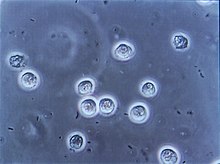Polyuria
| Polyuria | |
|---|---|
| Other names | Urination - excessive amount[1] |
 | |
| Regulation of urine production by ADH and aldosterone | |
| Specialty | Endocrinology, nephrology |
| Causes | Polydipsia, Psychogenic polydipsia[2][3] |
| Diagnostic method | Urine test and blood test[4] |
| Treatment | Depends on cause[5](See cause) |
Polyuria (
Causes
The most common cause of polyuria in both adults and children is uncontrolled

List of causes


- polydipsia[3]
- psychogenic polydipsia[2]
- osmotic diuresis[11]
Urinary system
- interstitial cystitis[12]
- urinary tract infection[13]
- renal tubular acidosis[14]
- Fanconi syndrome[15]
- nephronophthisis (genetic)[16]
Hormonal
- hypokalemia[17]
- diabetes mellitus[18]
- corticosteroid use[19]
- pheochromocytoma[20]
- hyperparathyroidism[21]
- diabetes insipidus[22]
- hypercalcaemia[23]
- hyperthyroidism[24]
- hypopituitarism[25]
- Conn's disease[26]
- hyperglycaemia[27]
Circulation
- congestive heart failure[28]
- cardiorespiratory disease[29]
- postural orthostatic tachycardia syndrome (POTS)[30]
Neurologic
- cerebral salt-wasting syndrome[31]
- neurologic damage[32]
- migraine[33]
Other
Mechanism
Polyuria, in osmotic cases, increases flow amount in the distal nephron where flow rates and velocity are low. The significant pressure increase occurring in the distal nephron takes place particularly in the cortical-collecting ducts. One study from 2008 laid out a hypothesis that hyperglycaemic and osmotic polyuria play roles ultimately in diabetic nephropathy.[40]
Diagnosis
Among the possible tests to diagnose polyuria are:[4]
- Urine test
- FBC
- Blood test
- Pituitaryfunction test
Treatment
Depending on the cause of the polyuria, the adequate treatment should be afforded. According to NICE, desmopressin can be considered for nocturnal polyuria, which can be caused by diabetes mellitus,[5] if other medical treatments have failed. The recommendation had no studies that met the criteria for consideration.[41]
See also
References
- ^ a b "Urination – excessive amount". Medline Plus. United States National Library of Medicine. 27 December 2013. Retrieved 30 December 2014.
- ^ ISBN 9781444320664. Retrieved 5 August 2015.
- ^ ISBN 978-0-7817-9153-3. Retrieved 5 August 2015.)
{{cite book}}:|first1=has generic name (help)CS1 maint: multiple names: authors list (link - ^ a b "Polyuria. Medical Professional reference for Polyuria. | Patient". Patient. Retrieved 2015-11-08.
- ^ ISBN 9783642548598.
- ^ a b c "Polyuria". Merck Manuals. November 2013. Retrieved 30 December 2014.
- ^ "Definition of Diuresis". MedTerms. 30 October 2013. Retrieved 30 December 2014.
- ^ "Diuresis". The Free Dictionary. Retrieved 30 December 2014.
- ISBN 9789351520931.
- ^ Research, Institute of Medicine (US) Committee on Military Nutrition; Marriott, Bernadette M.; Carlson, Sydne J. (1996), "Fluid Metabolism at High Altitudes", Nutritional Needs In Cold And In High-Altitude Environments: Applications for Military Personnel in Field Operations, National Academies Press (US), retrieved 2024-03-04
- ISBN 978-1416042525. Retrieved 5 August 2015.
- ISBN 978-0323081320. Retrieved 5 August 2015.
- ISBN 978-0-7020-4091-7. Retrieved 5 August 2015.)
{{cite book}}:|first1=has generic name (help)CS1 maint: multiple names: authors list (link - )
- )
- ISBN 978-3-642-35572-1. Retrieved 6 August 2015.
- ISBN 9781582556680. Retrieved 5 August 2015.
- ISBN 978-0-8036-1498-7. Retrieved 5 August 2015.)
{{cite book}}:|first1=has generic name (help)CS1 maint: multiple names: authors list (link - ISBN 978-0-7020-4762-6. Retrieved 6 August 2015.)
{{cite book}}: CS1 maint: multiple names: authors list (link - ^ "Pediatric Pheochromocytoma Clinical Presentation". Medscape.com. eMedicine. Retrieved 6 August 2015.
- ISBN 978-81-8448-104-4. Retrieved 6 August 2015.
- ISBN 978-0-19-935828-1. Retrieved 6 August 2015.)
{{cite book}}:|first1=has generic name (help)CS1 maint: multiple names: authors list (link - ISBN 978-1-907904-25-7. Retrieved 6 August 2015.
- PMID 22021708. Retrieved 6 August 2015.
- ^ "Panhypopituitarism Clinical Presentation". Medscape.com. eMedicine. Retrieved 6 August 2015.
- ISBN 978-0-7216-0324-7. Retrieved 6 August 2015.
- ISBN 978-1-4511-1656-4. Retrieved 6 August 2015.
- ISBN 978-1-85233-924-1. Retrieved 6 August 2015.
- ISBN 978-0443073038.)
{{cite book}}: CS1 maint: multiple names: authors list (link - ISBN 978-184619-433-7. Retrieved 6 August 2015.)
{{cite book}}: CS1 maint: multiple names: authors list (link - ISBN 978-1-4471-6355-8. Retrieved 6 August 2015.)
{{cite book}}:|first1=has generic name (help)CS1 maint: multiple names: authors list (link - ISBN 978-1-4200-0798-5. Retrieved 6 August 2015.
- ^ "Migraine Headache Clinical Presentation". Medscape.com. eMedicine. Retrieved 6 August 2015.
- ISBN 978-0-323-02964-3. Retrieved 6 August 2015.)
{{cite book}}: CS1 maint: multiple names: authors list (link - ISBN 978-1-55009-026-0. Retrieved 6 August 2015.)
{{cite book}}:|first1=has generic name (help)CS1 maint: multiple names: authors list (link - ISBN 978-0-7817-7332-4. Retrieved 6 August 2015.)
{{cite book}}:|first1=has generic name (help)CS1 maint: multiple names: authors list (link - ISBN 978-81-7179-648-9. Retrieved 6 August 2015.
- ^ "Hemochromatosis Clinical Presentation". Medscape.com. eMedicine. Retrieved 6 August 2015.
- PMID 12857779.
- PMID 18456680.
- ^ "Nocturia and nocturnal polyuria in men with lower urinary tract symptoms: oral desmopressin | key-points-from-the-evidence | Advice | NICE". www.nice.org.uk. Retrieved 2015-08-03.
Further reading
- Movig, K. L. L.; Baumgarten, R.; Leufkens, H. G. M.; Laarhoven, J. H. M. Van; Egberts, A. C. G. (2003-04-01). "Risk factors for the development of lithium-induced polyuria". The British Journal of Psychiatry. 182 (4): 319–323. PMID 12668407.
- Kreder, Karl; Dmochowski, Roger (2007-07-10). The Overactive Bladder: Evaluation and Management. CRC Press. ISBN 9780203931622.
